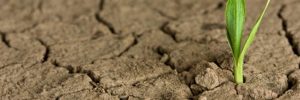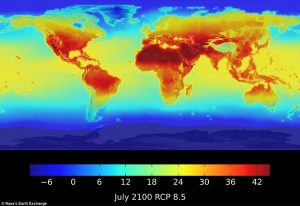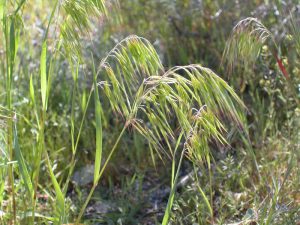Looking at the potential future impacts of climate change on global plant life By Catherine Savage, University of Southampton student
The human race is turning over a new leaf – but not in a good way.
As we enter a new era, the Anthropocene, what will be the fate for plant life on earth?

Everyone knows what climate change is, everyone knows that it is a current hot topic, but does everyone know what is happening to our plants because of it?
Global temperatures have risen 0.9 degrees throughout the last century (IPCC, 2013). This is predicted to rise by 4 degrees before 2100 (Thuiller, 2007). A shocking reality to grasp, yet global temperature change is only one aspect encompassed in the concept of climate change. What about changes in rainfall? Ice sheet melting? Sea level rise?
So, what are the underlying causes of climate change? Out of the greenhouse gases, carbon dioxide contributes the most to global warming at 65%. Current carbon dioxide concentration in the atmosphere is 387ppm, exceeding the safe level of 350ppm (Hansen et al., 2015). This has been heightened by fossil fuel burning and land-use change. The extra CO2 increases the greenhouse effect, resulting in trapped heat in the atmosphere which causes warming of the planet (Oktyabrskiy, 2016). For plants, this could either be a blessing or a curse.

The good…
Climate change may be beneficial for plants:
- Enhanced CO2 can increase the photosynthetic rate of plants, which could balance the effect of temperature increases (Thuiller, 2007).
- With warmer soils, the decomposition rate of organic matter will increase, allowing plants a higher mineral and nutrient availability.
- Growing seasons for crops may be extended and we could witness an improved agricultural productivity (Brown et al., 2016).
The bad…
However, it would be reckless to keep adding CO2 to the atmosphere. Too much of a good thing can be a bad thing right? Once you increase one substance, plants need to increase the rest too! Plants will be incapable of meeting these new requirements.
Changes in rainfall patterns and temperatures can further exacerbate abiotic stresses such as (Naithani, 2016):
- Drought
- Waterlogged soils
- Saltwater inversion
- Metal contamination
These impacts and more make it hard for plants to thrive, with the overarching impact of stunted growth (Worland, 2015).

Plus, non-native plant species may cross frontiers as conditions become more suitable, out-competing native plants (Thuiller, 2007; Smith et al., 2016; Walter et al., 2002).
The species of long grass, Bromus tectorum, has risen above native plant species in western North America due to being more suited to changes in the wet seasons (Smith et al., 2000).
The ugly…
The human race is a selfish species, perhaps the only way to kick people into action is to present the fact that no plants means no food. Crops won’t grow, land will become barren and food insecurity will explode (Worland, 2015). Could climate change wipe out homo sapiens as well as the worlds plants?
On a lighter note, the outlook may seem dire, but it is not too late for change. As the UN Secretary General Ban Ki-Moon quite rightly stated we are “the last generation that can end climate change”. We can protect and preserve our plants that will provide security to our future generations. Let’s all stop waiting for someone else to solve our problems, and be the change ourselves.
Word count: 499
References:
- IPCC (2013) Climate change: the physical science basis. Working group contribution to the fifth assessment report of the intergovernmental panel on climate change. Cambridge University Press, Cambridge, UK and New York, USA.
- Thuiller, W. (2007) Biodiversity: climate change and the ecologist.Nature,448(7153), pp.550-552.
- Hansen, J., Sato, M., Ruedy, R., Lo, K., Lea, D.W. and Medina-Elizade, M. (2015) Global temperature change. Proceedings of the National Academy of Sciences, 103(39), pp.14288-14293.
- Oktyabrskiy, V.P. (2016) A new opinion of the greenhouse effect.St. Petersburg Polytechnical University Journal: Physics and Mathematics,2(2), pp.124-126.
- Brown, I., Thompson, D., Bardgett, R., Berry, P., Crute, I., Morison, J., Morecroft, M., Pinnegar, J., Reeder, T., and Topp, K. (2016) UK Climate Change Risk Assessment Evidence Report: Chapter 3, Natural Environment and Natural Assets. Report prepared for the Adaptation Sub-Committee of the Committee on Climate Change, London.
- Gray, R. (2015) Our scorched Earth in 2100: Nasa maps reveal how climate change will cause temperatures to soar. [online] Available at: http://www.dailymail.co.uk/sciencetech/article-3125113/Earth-2100-Nasa-maps-reveal-world-need-adapt-rising-temperatures-caused-climate-change.html [Accessed 20 March 2017].
- Naithani, S. (2016) Plants and global climate change: A need for sustainable agriculture. Current Plant Biology,6(2), p.1.
- Worland, J. (2015) The weird effect climate change will have on plant growth. [Blog]Time. Available at: http://time.com/3916200/climate-change-plant-growth/ [Accessed 6 Mar. 2017].
- Smith, S.D., Huxman, T.E., Zitzer, S.F., Charlet, T.N., Housman, D.C., Coleman, J.S., Fenstermaker, L.K., Seemann, J.R. and Nowak, R.S., (2000) Elevated CO2 increases productivity and invasive species success in an arid ecosystem.Nature,408(6808), pp.79-82.
- Walther, G.R., Post, E., Convey, P., Menzel, A., Parmesan, C., Beebee, T.J., Fromentin, J.M., Hoegh-Guldberg, O. and Bairlein, F., (2002) Ecological responses to recent climate change.Nature,416(6879), pp.389-395.
Read more:
http://journal.frontiersin.org/article/10.3389/fpls.2016.01123/full
http://www.open.edu/openlearncreate/mod/oucontent/view.php?id=22627&printable=1
Recent Comments